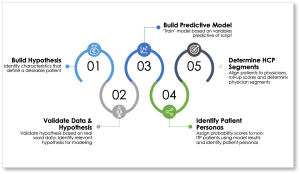
The Situation
Due to fierce competition and the impact of COVID-19, a mid-sized pharmaceutical company with a portfolio of drugs in rare disease faced severe challenges in trial and adoption of its immune thrombocytopenia (ITP) drug.
Lack of HCP awareness and a small sales force challenged the manufacturer, despite the drug’s strong clinical value proposition against competitive drugs. While evidence suggested that HCPs who tried the drug consistently became adopters, getting information into the hands of the right HCPs remained a struggle.
This client sought to increase their market share by identifying patient personas that had a high potential for trial of their therapy based on key identifying factors. Due to the size of their sales force, it was critical that they optimize their HCP targeting efforts. Through this potential patient identification process, they hoped to link patients to their corresponding HCPs in order to maximize their sales force impact.

The Solution
EVERSANA’s Data & Analytics team partnered with this client to build a proprietary, multi-step predictive modeling and analysis solution to determine, with high accuracy and precision, the highest potential patients for the brand:
- Build Hypothesis: Worked closely with the client’s brand, marketing and medical teams, to document the patient journey along with key identifying factors likely to be predictive of a willingness to trial.
- Validate Data & Hypothesis: Analyzed Real World Data (RWD) to determine patterns of healthcare utilization, clinical events and treatment. These specific micro-moments in the patient journey were used to guide the construction of a predictive model that identified the optimal treatment for the right patient at the right time.
- Build Predictive Model: Evaluated five algorithmic approaches, then built the optimal predictive model (such as the Chi Squared Automated Interaction Detection (CHAID) algorithm) that evaluated multiple factors including patient demographics, diagnosis codes, physicians, prescription volumes, side effects, comorbidities, treatment options, treatment history and insurance claims data, along with other relevant variables.
- Identify Patient Personas: The model helped classify patients into three different personas:
- Chronic Condition (longer therapy duration with high comorbidity and side effect scores)
- Competitor Users (High use of competitive product with average therapy duration, comorbidity and side effect scores)
- New Joiners (Short therapy duration, low comorbidity and side effect scores)
- Determine HCP Segments: Identified HCPs associated with the predicted patients and created 4 distinct HCP segments based on their current prescribing patterns and future potential along with prioritization recommendation.

The Results
Based on the proprietary predictive modeling techniques:
- Over 1.5K patients from the three distinct patient persona groups were identified as having a high likelihood of brand trial (75% + probability).
- Over 780 unique HCPs were identified as being associated with these patients and their corresponding information was provided to the client as a key target list.
- Through targeted sales force interaction, this list generated ~80% of the new patients who engaged in a trial of this therapy over a period of nine months


